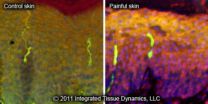(Press-News.org) National Institute of Standards and Technology (NIST) researchers are working to reduce the uncertainty associated with climate-change measurements using a mobile temperature-sensing technology made for tracking delicate or perishable, high-value packages in transit. Developed by international shipper FedEx and tested with help from NIST, the device connects to cell phone networks to provide users with near real-time information on the package's precise location, temperature, humidity, pressure, acceleration, elevation and exposure to light.
Senseaware tag
Developed by international shipper FedEx and tested with help from NIST, the Senseaware device connects to cell phone networks to provide users with near real-time information on a package's precise location, temperature, humidity, pressure, acceleration, elevation and exposure to light. NIST researchers plan to deploy the technology as part of a pilot project to monitor and improve climate measurements.
Historically, package tracking has provided information to customers about a package's route and anticipated delivery date and time. Seeking to provide customers with more information on the "vital signs" of their shipments, the company approached NIST about the feasibility of achieving accurate temperature measurements in a mobile device.
"The primary function of the device is to monitor temperature-sensitive materials such as medicines and vaccines, tissues, organs, blood, etc.," says Greg Strouse, leader of NIST's Temperature and Humidity Group. "We tested the beta units when they were transmitting information and when they were simply recording it, and we found that the devices create heat when transmitting, which throws off the measurement. To fix that, we developed performance data and an algorithm that kicks in to correct the temperature measurement when the device is actively communicating."
Once all the kinks were ironed out, Strouse and his group worked with the National Voluntary Laboratory Accreditation Program (NVLAP), a NIST service that tests and accredits independent testing laboratories, to help the company find a capable, independent lab to test the devices en masse.
The result was a palm-sized device that a customer can place inside a package. The customer can monitor the transit of their package in real time through a Web-based interface. A GPS receiver in the device provides location information, and the device sends updates on its status wherever it can get a cell phone signal. It even monitors the shipments while aboard airplanes and transmits the data upon landing.
Accurate to within 0.02 degrees Celsius and able to send and store data for up to 30 days, the technology lent itself quite easily to another NIST project focused on measurements for climate change. The device's connectivity and accuracy make it ideal for monitoring surface air temperature, which climate scientists often use to evaluate the performance of their models.
"Because continuous measurement can be more informative than daily minimum and maximum temperature observations, we're looking into the potential for using these devices as prototype weather stations and comparing their results with the analog and digital style instruments used for weather observations," says Strouse. "Our goals are to better understand and quantify the measurement uncertainty of both the historical analog and current digital measurement systems as well as improving the science base for metrology used in surface air temperature measurements."
NIST is planning to station three of the devices at locations around the NIST campus in Gaithersburg, Md. The group intends to also erect a tower to mount one of the devices to better understand 3-D temperature gradient mapping strategies near the surface.
INFORMATION:
For more information on the new technology, see www.senseaware.com. For more information on NIST's climate measuring activities, see www.nist.gov/climate-science-portal.cfm.
Temperature tracking device for packages may have climate metrology applications
2011-06-09
ELSE PRESS RELEASES FROM THIS DATE:
Researchers discover potential cause of chronic painful skin
2011-06-09
June 6, 2011 – (Rensselaer, N.Y., USA) – A new study may explain why only 50% of patients experiencing chronic nerve pain achieve even partial relief from existing therapeutics. The study, published in the June 6 online version of the international research journal PAIN, reveals that certain types of chronic pain may be caused by signals from the skin itself, rather than damage to nerves within the skin, as previously thought.
A Medical Mystery
For years, researchers have known that increased amounts of a molecule called Calcitonin Gene-Related Peptide (CGRP) is ...
VELUX Solar Water Heating System and Sun Tunnel Skylight in Concept Home
2011-06-09
A VELUX America solar water heating system and Sun Tunnel skylight are included in the KB Home GreenHouse: An Idea Home Created with Martha Stewart, at the 2011 International Builders' Show in Orlando.
The home is slated to be the first net-zero energy, single-family home in the Builder Magazine Concept Home series. The KB Home GreenHouse will also demonstrate to consumers that this environmentally friendly home not only saves energy and water through the use of solar and thermal systems and meeting EPA's WaterSense for new homes specifications, but can also save them ...
VELUX Expands Solar Water Heating Product Line in U.S.
2011-06-09
VELUX America has expanded its solar water heating product line in the U.S. to include packaged solar water heating systems for homeowners in all markets across the country.
Jim Cika, manager, solar products for VELUX America, says VELUX has three major additions to the solar product line that will open the solar water heating market to U.S. homeowners. He says that the addition of gas backup solar systems, rack mounted collector systems, and smaller size, one-collector/60 gallon tank solar systems, will provide most homeowners with a solar thermal option to meet their ...
U-M researchers advocate national strategic approach to therapeutic cancer vaccines
2011-06-09
ANN ARBOR, Mich. — Vaccines that save lives by preventing disease have been around for centuries. Now, new vaccines that treat cancer are being developed, but how they will be combined with existing treatments is not clear.
Researchers at the University of Michigan Health System recommend that a national strategy be developed for bringing therapeutic cancer vaccines to patient care, so that cancers with less effective treatment options are priority targets.
"Vaccines that prevent disease have profoundly changed the lives of billions of people around the world," says ...
Research identifies how cancer cells cheat death
2011-06-09
Research led by David Litchfield of The University of Western Ontario has identified how biochemical pathways can be "rewired" in cancer cells to allow these cells to ignore
signals that should normally trigger their death. It's one way that cancer cells may become resistant to therapy. The findings are now published in Science Signaling
(http://stke.sciencemag.org/cgi/content/full/sigtrans;4/172/ra30 ).
"This work focused on understanding how cancer cells acquire a selective survival advantage, allowing them to avoid apoptosis, the process required for normal cell ...
Scientists create humanized mouse model for hepatitis C
2011-06-09
Scientists at Rockefeller University and The Scripps Research Institute have developed the first genetically humanized mouse model for hepatitis C, an achievement that will enable researchers to test molecules that block entry of the hepatitis C virus into cells as well as potential vaccine candidates. The finding is reported in the June 9 issue of the journal Nature.
While the hepatitis C virus can infect chimpanzees and humans, scientists have been unable to study the progression of the virus' life cycle or possible treatments in small animal models. The new mouse model ...
THE VELUX Group Wins Design Award for Sun Tunnel Skylight by Lovegrove; Partnership Between VELUX & Green Design Proponent Wins Sought-After 'Red Dot' Label
2011-06-09
A very unusual partnership between the VELUX Group and the internationally acknowledged proponent of Green Design, Ross Lovegrove, wins this year's attractive red dot award "best of the best" for pioneering design.
The sun tunnel by Lovegrove is a contemporary and smooth new product that spreads natural light through the roof to otherwise electrically lit rooms and is a supplement to the ordinary VELUX sun tunnel. The new design represents yet another innovative way to bring daylight into buildings. The "red dot" is a sought-after quality label worldwide. ...
Connection discovered between the nervous system and the vascular system
2011-06-09
Montréal, June 8, 2011 – Dr. Frédéric Charron, researcher at the Institut de recherches cliniques de Montréal (IRCM), and his team have shown for the first time that a key molecule of the vascular system directs axons during the formation of neural circuits. This connection between the nervous system and the vascular system could be a good starting point for the development of therapies for neurodegenerative diseases. The discovery will be published tomorrow by Neuron, a scientific journal of the Cell Press group.
"To properly form neural circuits, developing axons (long ...
Competition between females leads to infanticide in some primates
2011-06-09
An international team of scientists, with Spanish participation, has shed light on cannibalism and infanticide carried out by primates, documenting these acts for the first time in the moustached tamarin (Saguinus mystax). The mothers, which cannot raise their infants without help from male group members, commit infanticide in order to prevent the subsequent death of their offspring if they are stressed and in competition with other females.
"Infanticide is an extreme behaviour, and in most species is used by males to eliminate competitors and make females become sexually ...
VELUX Introduces the Sun Tunnel Skylight Shade
2011-06-09
VELUX America is introducing a manual blackout shade for its Sun Tunnel tubular skylights.
The new accessory utilizes magnets on the top, or non-visible side, of the ceiling diffuser trim ring. When the magnets are in place and the trim ring is reinstalled, a white, fabric-covered disk with a metal outer ring is attached to the diffuser trim ring. The center of the disk has a fitting that connects to a two-piece, 26.5" rod, which is inserted into the fitting and used to attach and remove the accessory shade disk.
The accessory kit (ZTB designation) is available ...

